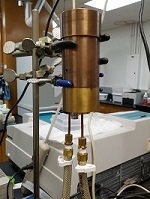The kinetics of aqueous reactions

Equilibrium constants for aqueous systems that exist deep in the earth’s crust are of great importance for chemists and geochemists. There exists a number of theoretical methods to determine equilibrium constants but remain mostly untested above pressures of 0.5 GPa. Our group is interested in using NMR as an analytical technique to determine these equilibria for these aqueous systems. In order to do so, a wide bore high pressure NMR probe was constructed for the collection of spectra at pressures up to 2.0 GPa. NMR data for 2H, 27Al, 133Cs, 139La and other broadband nuclei can be collected. Some future work to be done is the construction of a narrow bore high pressure probe and the collection of high resolution 1H data using a low field permanent magnet.




